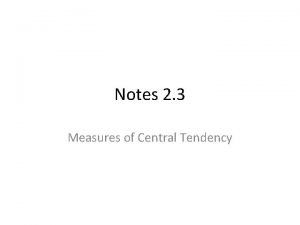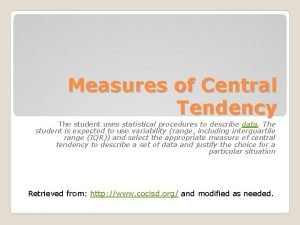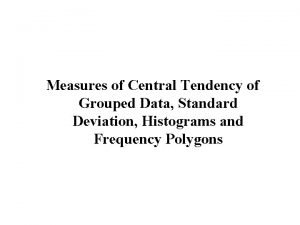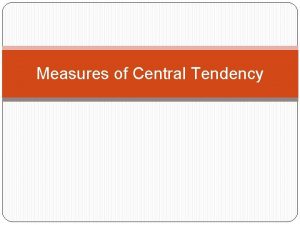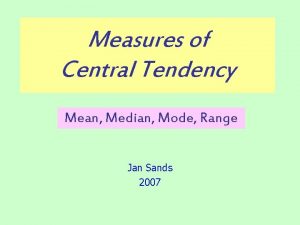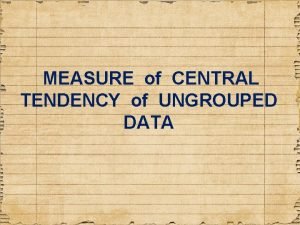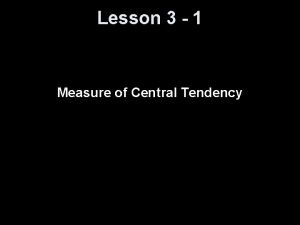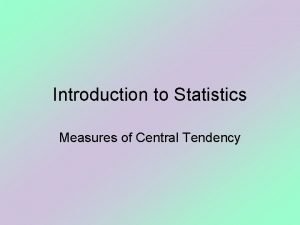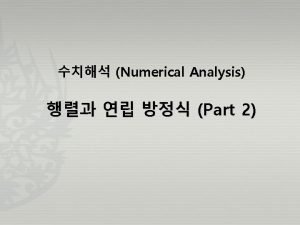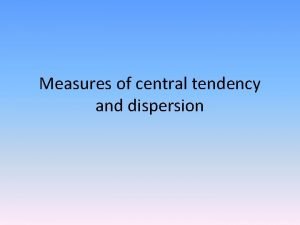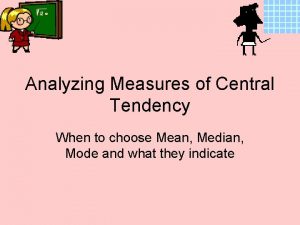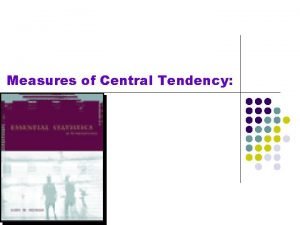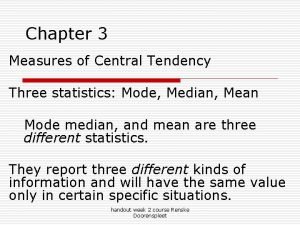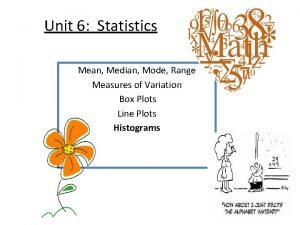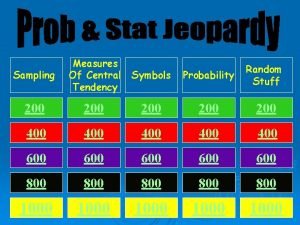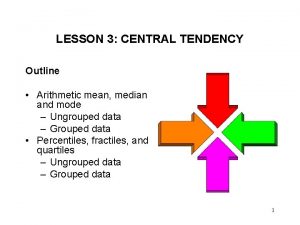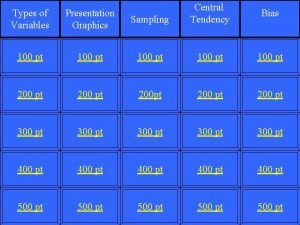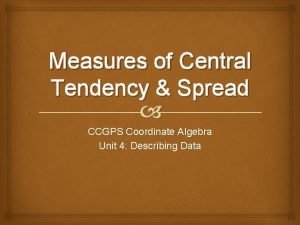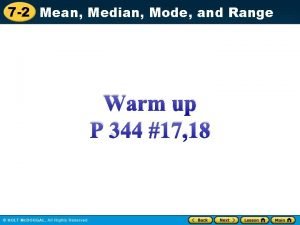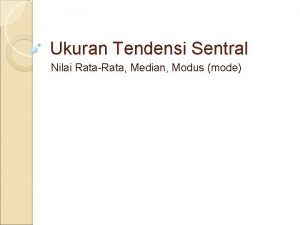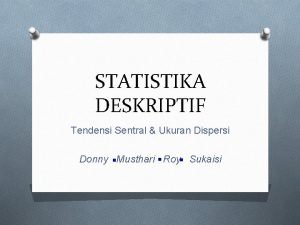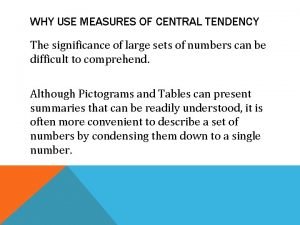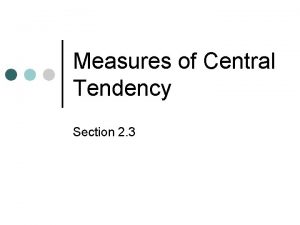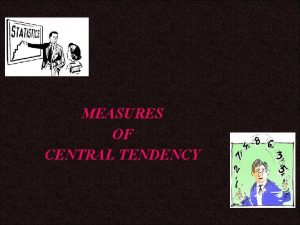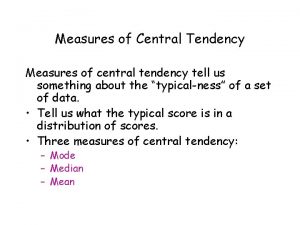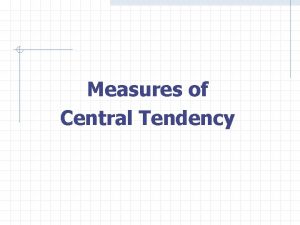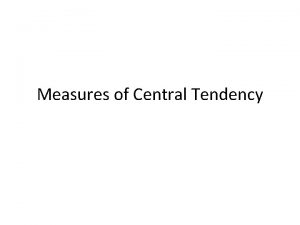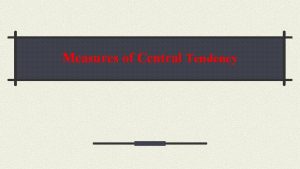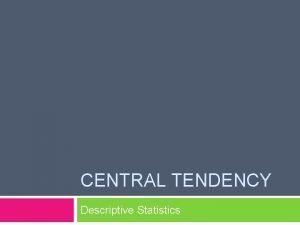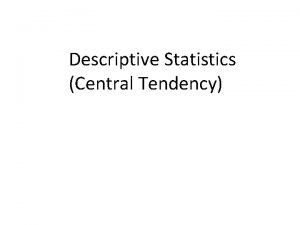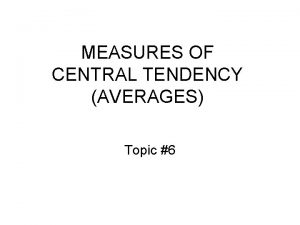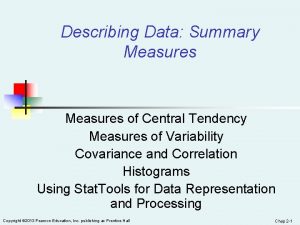Notes 2 3 Measures of Central Tendency Central

































- Slides: 33

Notes 2. 3 Measures of Central Tendency

Central Tendency • A measure of central tendency is a value that represents a typical or central entry of a data set. The most common ones are mean, median and mode. • Mean: the sum of all the entries, then divided by the number of entries in the data set

Find the mean • 12, 18, 19, 2, 18, 31, 24, 30, 9, 11, 14, 16, 18

• Median: is the middle data entry when the data is sorted is ascending (from smallest to greatest) or descending (from greatest to smallest) order. • Find the median • 8 9 11 1 14 2 15 17 18 19 31 24 9

• Mode: the entry with the greatest frequency. If no entry is repeated the data set has no mode. If two numbers have the same amount of frequency both numbers are the mode. • Ex 1 11 14 15 17 18 19 20 • Ex 2 4 8 9 14 15 8 19 21 7 31

Warm Up Find the mean, median and mode. Number of time someone has gone fishing. 1 0 4 0 5 0 34 0 1 0 2 4 0 0 2 1 0

Notes 2. 3 Part 2 Weighted Mean

Outlier • An outlier is a data entry that is far removed from the other data entries. • Do the following data sets have an outlier. • 1) 4 5 8 4 5 7 1 4 34 5 7 8 5 • 2) 1 2 3 4 4 3 2 5 1 3 5 4 3 4 2

• Which measure of central tendency best describes a typical data entry? • It all depends on whether the data entries have a outlier. – If the data set has an outlier the median is best – If a data set does not have an outlier the mean is best. – The mode is almost never the best to describe a data set.

• The mean is heavily influenced by an outlier that is why it is not the best method to describe a data set. 4 2 3 5 42 56 = 11. 2 5 Mean is 11. 2 • The median is not influenced by an outlier therefore when an outlier is present, it is the best method to describe 4 2 3 5 42 2 3 4 5 42 X X Median is 4

Weighted mean • Weighted mean: is the mean of a data set whose entries have varying weights. A weighted mean is given by

Weighted Mean Source Score x Test 82 Midterm 92 Final 72 Lab 98 HW 100 Weight w xw . 50. 15. 20. 10. 05 ∑w = ∑xw =

Weighted Mean Source Score x Weight w xw Test 82 Midterm 92 Final 72 Lab 98 HW 100 . 50. 15. 20. 10. 05 ∑w = 41 13. 8 14. 4 9. 8 5 ∑xw =

Weighted Mean Source Score x xw Test 82 Midterm 92 Final 72 Lab 98 HW 100 Weight w . 50. 15. 20. 10. 05 ∑w = 1. 00 41 13. 8 14. 4 9. 8 5 ∑xw = 84

Warm Up Frequency 10 51 Major Math Science History Find the weighted mean Salary 68000 72000 40000

Warm Up Frequency 24 31 51 Major Math Science History Find the weighted mean Salary 68000 72000 40000

Notes 2. 3 (Part 3) Grouped Data

Grouped Data Equation Useful for when there a lot of data entries. 2 4 9 10 10 10 11 11 12 13 14 15 17 17 17 18 18 19 19 20 21 21 21 24 25 27 28 28 28 29 31

Grouped Data Mean Equation

Grouped Data Example Age 0 -8 9 -17 18 -26 27 -35 ∑∫= F 2 15 12 6 Midpoint (x) ∑x∫= xf

Grouped Data Example Age 0 -8 9 -17 18 -26 27 -35 ∑∫= F 2 15 12 6 Midpoint (x) xf 4 13 22 31 ∑x∫=

Grouped Data Example Age F Midpoint (x) 0 -8 2 4 9 -17 15 13 18 -26 12 22 27 -35 6 31 ∑∫= ∑x∫= xf 8 195 264 186

Grouped Data Example Age F Midpoint (x) xf 0 -8 2 4 8 9 -17 15 13 195 18 -26 12 22 264 27 -35 6 31 186 ∑∫= 35 ∑x∫= 653

Example #1 ∑x∫ = 625 = 18. 66 ∑∫ 35

Notes 2. 3 (Part 4) Finding GPA

Shapes of Distribution Go to page 63 and copy the four shapes of distribution. Make sure to copy the shape of the graph. 1. Symmetric 2. Uniform 3. Skewed Left 4. Skewed Right

How to find your GPA All classes are not created equal in colleges and universities. Some are worth 1 credit, 2 credit, 3 credits and some are even worth 6 to 7 credits. Lets calculate a sample GPA

Example 1 B in one 3 unit class D in one 5 unit class

Example 1 B in one 3 unit class D in one 5 unit class Class Unit/Credit Grade Total

Example 1 B in one 3 unit class D in one 5 unit class Class 1 1 Unit/Credit 3 5 Grade 3 1 Total 9 5

Example 1 B in one 3 unit class D in one 5 unit class Class Unit/Credit 1 3 1 5 ∑unit= Grade Total 3 9 1 5 ∑total=

Example 1 B in one 3 unit class D in one 5 unit class Class Unit/Credit 1 3 1 5 ∑unit= 8 Grade Total 3 9 1 5 ∑total=14

Example 1 Class Unit/Credit 1 3 1 5 ∑unit= 8 ∑total = 14 = 1. 75 GPA ∑unit 8 Grade Total 3 9 1 5 ∑total=14
 Measures of central tendency notes
Measures of central tendency notes Measures of central tendency
Measures of central tendency Grouped data measures of central tendency
Grouped data measures of central tendency Objective of central tendency
Objective of central tendency Range in central tendency
Range in central tendency Measures of central tendency for ungrouped data
Measures of central tendency for ungrouped data Objectives of measures of central tendency
Objectives of measures of central tendency Measures of central tendency
Measures of central tendency Interquartile range in grouped data
Interquartile range in grouped data Measures of central tendency
Measures of central tendency Advantages of central tendency
Advantages of central tendency Choosing the best measure of central tendency worksheets
Choosing the best measure of central tendency worksheets Central tendency
Central tendency What is the lower boundary of the modal class
What is the lower boundary of the modal class Measures of central tendency and variation
Measures of central tendency and variation Measures of central tendency and variation
Measures of central tendency and variation Statistics chapter 3 measures of central tendency
Statistics chapter 3 measures of central tendency Mode in statistics
Mode in statistics Measures of central tendency symbols
Measures of central tendency symbols Measures of central tendency median
Measures of central tendency median Mean ka formula
Mean ka formula Anova repeated measures
Anova repeated measures Central tendancy bias
Central tendancy bias Central tendency and spread homework
Central tendency and spread homework Use of central tendency
Use of central tendency Central tendency
Central tendency How do you do mean median mode and range
How do you do mean median mode and range Contoh tendensi
Contoh tendensi Ukuran tendensi sentral adalah
Ukuran tendensi sentral adalah Fraktil
Fraktil Variance meaning
Variance meaning Importance of central tendency
Importance of central tendency Central tendency chart
Central tendency chart Central tendency symbols
Central tendency symbols
